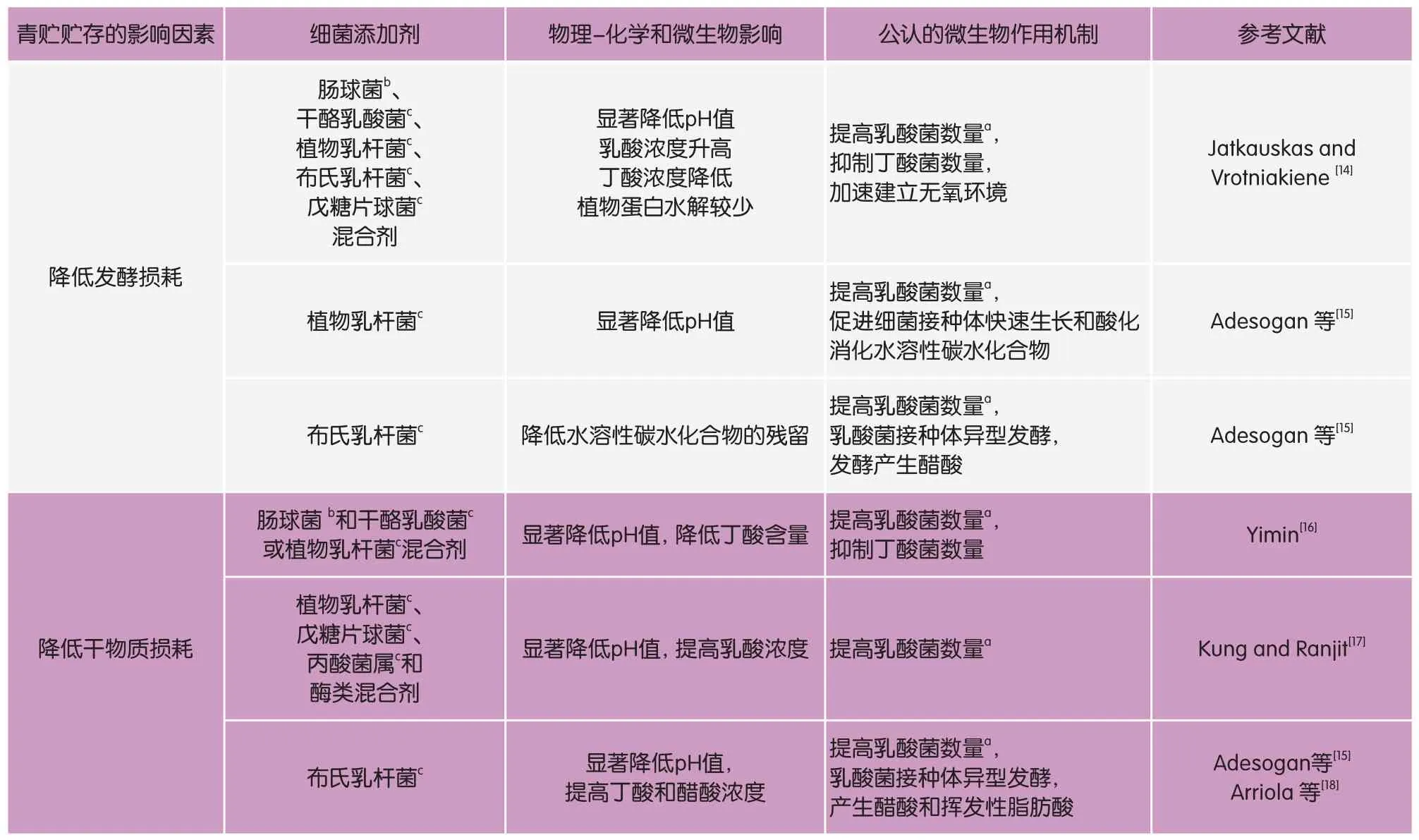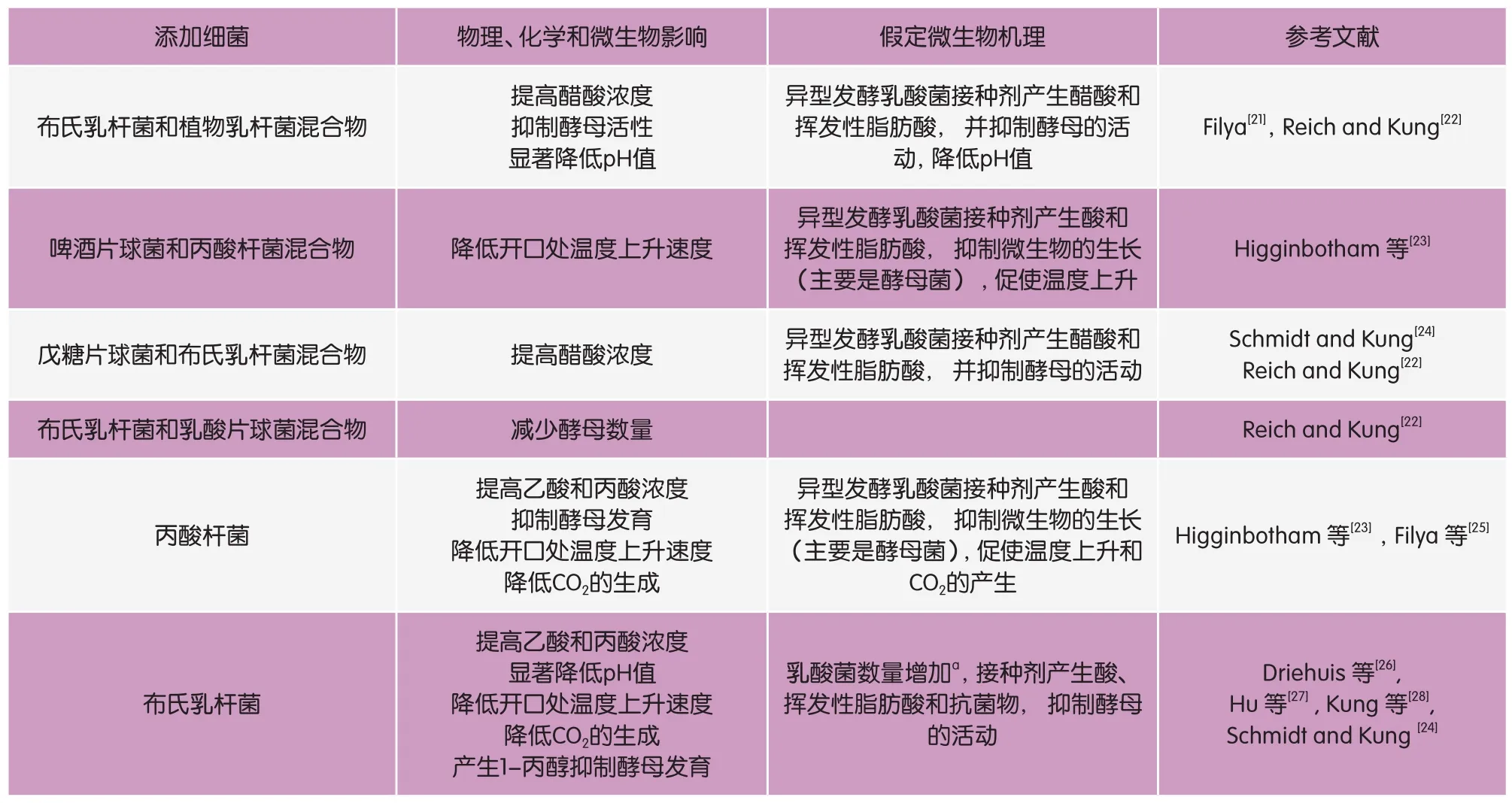防止青贮饲料中存留有害微生物的工艺与策略
2017-11-24王东升张露露刘祯
王东升,张露露,刘祯
(1.上海光明荷斯坦牧业有限公司,上海 200436;2.北京中农榜样蛋鸡育种有限责任公司,北京 102100)
防止青贮饲料中存留有害微生物的工艺与策略
王东升1,张露露2,刘祯1
(1.上海光明荷斯坦牧业有限公司,上海 200436;2.北京中农榜样蛋鸡育种有限责任公司,北京 102100)
青贮是基于乳酸菌在无氧条件下产生的有机酸来保存高水分农作物的一种方法。然而,青贮饲料也可以作为有害微生物的载体,损害农作物的保存、动物的生产性能,以及动物和人类的健康。为了提高青贮饲料的保存期和品质,一些化学类、 酶类以及菌类青贮添加剂被应用到青贮加工过程中。本文的目的是回顾存在于青贮加工过程中的有益和有害微生物,介绍了防止青贮饲料中存留有害微生物的工艺与策略,以便为青贮饲料的生产质量管理提供参考依据。
青贮;有害微生物;生产管理规范
青贮是无氧条件下基于自然乳酸发酵的一种保存农作物的方法[1]。青贮的主要目的是保持青饲料的全年可利用性,而且由于青贮饲料最大限度地保存了青饲料的营养成分,加之较高的性价比,从而成为反刍动物主要的饲料来源。青贮饲料在提高畜牧生产的经济效益和环境的可持续性方面反挥重要作用。制作青贮饲料最主要的农作物是全株玉米、紫花苜蓿以及其他多种牧草[2]。
青贮加工过程涉及步骤较多,如果处理不当就会导致青贮饲料中存留有害微生物,饲喂家畜会影响其健康及生产性能,给牧场造成巨大的经济损失,甚至给人类健康带来风险。本文概括介绍了防止青贮饲料中存留有害微生物的工艺与策略,以供行业同仁参考。
1 青贮饲料加工过程
青贮饲料加工过程包括以下步骤:在最佳成熟期收割、切断、存入、压实、封闭隔离空气、储存和最终开窖供动物饲用。用生物化学和微生物学来描述青贮饲料加工过程,可分为需氧阶段、发酵阶段、青贮阶段和开窖阶段四个阶段[3]。不同阶段理论氧含量、pH值及不同微生物种群变化见图1。

图1 青贮饲料加工过程中不同阶段理论氧含量、pH 值及不同微生物种群的变化[4]
2 有害微生物及其代谢产物
青贮饲料中易存留的有害微生物及其代谢产物会对动物和人类健康带来不良影响。
2.1 酵母菌和霉菌
在青贮初期或开窖使用阶段,酵母菌被认为是参与有氧腐败最重要的有害微生物群体[5]。酵母菌具有耐酸性,在开窖使用阶段青贮饲料的氧化作用重新启动了其有机酸(琥珀酸、柠檬酸和乳酸)代谢途径,造成青贮料pH值升高,抑制了耐酸性微生物的生长,从而损害青贮饲料质量,降低动物的采食量[6]。
青霉菌、镰刀菌和曲霉菌是从玉米青贮饲料中分离出的最活跃的可产生毒素的真菌[7]。这些真菌可在青贮玉米饲料中产生300种霉菌毒素,其中危害最大的是黄曲霉毒素[8]。将含有黄曲霉毒素的青贮饲料喂给奶牛可造成肝脏损伤,导致免疫机能抑制、乳房炎发病率上升、产奶量降低及牛奶质量下降等多种不良后果。

表1 添加菌群促进青贮饲料酸化的防腐效果
2.2 其他有害细菌
除了酵母菌和霉菌,目前在青贮饲料中发现的有害细菌还有克氏杆菌、大肠杆菌、蜡状芽孢杆菌、迟缓芽孢杆菌和球形芽孢杆菌等腐败菌。
2.3 生物胺
生物胺(BA)是由几种乳酸菌在酶的作用下进行氨基酸脱羧反应产生的,这些乳酸菌包括乳酸杆菌属、明串珠菌属、肠球菌属和片球菌属等[9],其中多种菌可能出现在青贮饲料中,例如梭状芽孢杆菌、芽孢杆菌、克雷伯氏杆菌、埃希氏杆菌和假单胞菌等[10]。青贮饲料中发现的生物胺主要是腐胺、尸胺和酪胺,分别来源于精氨酸、赖氨酸和酪氨酸。生物胺被认为是酮血症的诱发因素,在发生酸中毒的反刍动物中瘤胃组胺的吸收被认为是引起系统性组胺症的主要原因[11]。

表2 青贮过程中添加异型发酵菌剂的作用以及其参与有氧稳定性的微生物机制
3 限制青贮饲料降解和减轻其经济损失及对人类健康影响的策略
3.1 控制病原微生物的侵入
病原微生物可以通过青贮仓和机械设备侵入青贮饲料中。因此在青贮之前进行有效清理可以明显减少污染的风险。青贮仓密闭管理可以避免啮齿类和鸟类动物与青贮饲料的接触,这些动物往往是病原微生物的潜在媒介。在饲喂青贮料之前要将料槽中剩余饲料清理干净,以避免动物因采食变质饲料而影响健康。
3.2 促进厌氧环境的建立
厌氧环境的迅速建立能够有效防止发酵液的产生以及促进乳酸菌的形成和酸化。加工制作时要将青贮原料迅速装进仓内,压平实以排净空气。由于植物细胞和好氧微生物的呼吸作用会产生一定的发酵液,而发酵液会引发一些环境问题,如引起水质BOD超标等[2]。因此,为了减少发酵液的产生,应该选用干物质含量在30%~40%的青贮原料,并将原料切割长度控制在4~6cm。
3.3 促进酸化作用
酸化是影响青贮饲料保存的主要因素,其依赖于厌氧活动、缓冲能力和青贮原料的干物质含量。青贮过程中若掺入土壤可增加青贮料缓冲能力[2]。如果缓冲能力过高,好氧微生物则会在青贮前期出现,并在一定程度上保持活力,进而导致接下来的乳酸菌发酵中己糖和戊糖品质降低。此时青贮饲料的发酵将会延迟,在pH值升高和进一步腐败之后,乳酸会转变成相对较弱的丁酸,由此将会开始由梭状芽孢杆菌引发的二次发酵。
过去认为矿物质酸(如硫酸和碳酸)能促进青贮饲料的酸化和限制病原微生物的生长。但由于矿物质酸对人类和动物有危害,所以现在更青睐于利用有机酸。但是必须注意,安全性是使用酸性物质的一个关键点,为防止酸性物质对皮肤、眼睛和呼吸道造成的腐蚀,目前主要选用有机酸盐,但必须加大其用量才能保证效果[12]。
此外,在青贮饲料发酵过程中可通过额外添加糖浆或者碳水化合物[6],以及通过添加纤维素酶促进植物细胞壁和半纤维素水解为糖类[13],进而促进酸化过程。
除添加化学物质和酶制剂外,接种细菌通常也被用于青贮饲料的保存。通过在青贮料中添加细菌可使有机酸快速生成,以减少发酵和干物质的流失(表1)。
3.4 青贮过程中防止空气进入
从开始入窖到整个青贮期都应该避免青贮作物营养物质流失。为达到此目标,通常使用聚乙烯塑料薄膜对青贮仓进行密封[19],防止空气进入青贮过程中。研究证明,青贮仓覆盖隔氧薄膜能有效抑制腐败和降低干物质损失,提高青贮饲料的稳定性[20]。
3.5 提高有氧稳定性
目前,细菌添加剂被广泛用于青贮料,以确保开窖后青贮料的有氧稳定性(表2)。尽管同型菌被认为是对青贮最有效的接种剂,但一些研究证实,在非厌氧条件下,乳酸被酵母菌用作底物会使青贮饲料变质[25]。因此,混合乳酸发酵是提高青贮饲料有氧稳定性的首选。
3.6 直接抑制有害微生物
为了确保青贮饲料的质量,通常是将能够抑制有害微生物生长的添加剂添加到青贮饲料中。研究发现,乌洛托品结合亚硝酸钠能够有效抑制梭状芽孢杆菌的生长,而苯甲酸钠则可以抑制酵母的生长[29]。甲酸钙、苯甲酸钠和亚硝酸钠混合使用可以得到高质量的青贮饲料,并且能够显著降低玉米赤霉烯酮、脱氧萎镰菌醇、总赫曲霉毒素以及总串珠镰孢菌素的浓度[30]。
国外多位学者曾对通过细菌接种限制病原微生物生长的机制进行研究,如表3所示。众所周知,除了有机酸,细菌接种也能够产生具有抗菌能力的一些物质:如双氧水、乙醇、二乙酰以及表多糖[31,32]和抗菌肽(细菌素类)[33]。

表3 细菌接种剂对青贮饲料中有害微生物生长、代谢的影响及其微生物机制
谷物中包含多种酚类化合物,如阿魏酸和对香豆酸,其为植物中存在的天然抗菌物质[37]。研究证实,酚类化合物能够改变大肠杆菌(O157∶H7和O111)[38]以及其他致病菌(产单核细胞、沙门氏菌和耶尔森菌属)[39]的细胞组成。阿魏酸酯主要用于促进瘤胃中的纤维消化[40]。接种阿魏酸酯可以通过阿魏酸的活性来反映青贮饲料的抗微生物效应。然而,目前大多数研究并没有着重研究其确切的抗微生物机制。在CAZy数据库中(http∶//www.cazy.org)根据其酶活性列出了细菌的种类[41]。乳酸杆菌属、乳酸球菌属、丙酸杆菌属以及肠球菌属在内的多种具有酯酶基因的菌属,都需要进一步对其潜在的抗微生物机制进行研究。
Niderkorn等[35]研究表明,乳酸菌通过形成稳定复合物的形式来中和镰刀菌毒素。而降低饲料中真菌毒素含量的最好方法就是防止这些毒素在田间产生。但仅仅这样是不够的,还要使用吸附剂。吸附剂能够在通过动物胃肠道时选择性地吸附去除毒素。还有一条途径是通过使用酶制剂或者是具有解毒功能的微生物[42]。
与酵母菌和真菌不同,有关细菌接种对利斯塔氏菌属[43]、梭菌属[44]或致病性大肠杆菌[45]这样的病原微生物抑制效应的研究较少。研究表明,接种戊糖片球菌和丙酸杆菌能够促进大麦青贮饲料中大肠杆菌O157∶H7的清除,而在青贮开始阶段添加布氏乳杆菌和动物源粪肠球菌能够分别抑制大肠杆菌O157∶H7和大肠杆菌O26的生长。GMP目前仍然是规范青贮饲料中病原微生物含量的主要依据。
4 结论
青贮的目的是为了保持青绿饲料的鲜嫩,并以此来保证家畜全年的饲料供应。其作用机制是基于厌氧乳酸发酵来维持作物的营养和品质。然而,青贮过程中极易滋生病原微生物,导致营养物质流失并造成极大的经济损失。 而且青贮饲料还可能会作为病原微生物的载体对动物和人类的健康构成威胁。因此在饲料领域,特别是青贮饲料领域,必须采取安全措施来阻止有害微生物存留预防动物疾病,以免其通过食物链威胁人类健康。研究表明,青贮加工保存过程遵循生产规范以及各种添加剂的使用,有利于青贮饲料的发酵和保存,并使之保持较高的营养水平。
[1]Gollop N, Zakin V, Weinberg ZG. Antibacterial activity of lactic acid bacteria included in inoculants for silage and in silages treated with these inoculants[J]. J. Appl. Microbiol., 2005,98:662-666.
[2]Weinberg Z, Ashbell G, Hen Y, et al. The effect of applying lactic acid bacteria at ensiling on the aerobic stability of silages[J]. J.Appl. Bacteriol.,1993,75:512-518.
[3]Ashbell and Weinberg. Silage Production and Utilization.Food and griculture Organization,FAO Electronic Library, 2006.
[4]Pitt R, Sniffen C. Agriculture Engineering[J]. Ext. Bull., Cornell University, 1985:452.
[5]Driehuis,F.,OudeElferink,S.J.The impact of the quality of silage on animal health and food safety:a review[J]. Vet.Q.,2000,22:212-216.
[6]AFFSSA.Bonnespratiques de fabrication de l’ensilage pour unemeilleuremaîtrise des risquessanitaires.AgenceFranc¸aise de Sécurité Sanitaire desAliments,2004.
[7]Roigé MB, Aranguren SM, Riccio MB, et al. Mycobiota and mycotoxins in fermented feed, wheat grains and corngrains in Southeastern Buenos Aires Province[J].Argentina. Rev. Iberoam.Micol.,2009,26:233-237.
[8]Murphy PA, Hendrich S, Landgren C, et al. Food mycotoxins: an update[J]. J. Food Sci.,2006,71:R51-R65.
[9]Krízek M. Biogenic amines in silage 2. The dynamics of the formation of biogenic amines in silage[J]. Arch.Tierernahr.,1993,43:179-187.
[10]Silla Santos MH. Biogenic amines: their importance in foods[J].Int.J.Food Microbiol.,1996,29:213-231.
[11]Aschenbach JR, Gäbel G. Effect and absorption of histamine in sheep rumen: significance of acidotic epithelial damage[J]. J.Anim. Sci.,2000,78:464-470.
[12]Kaiser AG. Silage additives. In: Kaiser, A.G., Piltz, J.W., Burns,H.M., et al. Successful silage[C]. TopFodder, Australia, 2004:468.
[13]Zhang J, Kawamoto H, Cai Y. Relationships between the addition rates of cellulase or glucose and silage fermentation at different temperatures[J].Anim. Sci. J., 2010,81:325-330.
[14]Jatkauskas J, Vrotniakiene V. The influence of application of a biological additive on the fermentation and nutritive value of lucernesilage[J].Zemdirbyste-Agricult, 2009,96:197-208.
[15]Adesogan,A.,Salawu,M.,Ross,A.,et al. Effect of Lactobacillus buchneri actobacillus, Lactobacillus fermentum,Leuconos tocmesenteroides inoculants,or a chemical additive on the fermentation,aerobic stability, and nutritive value of crimped wheat grains[J].J.Dairy Sci., 2003,86:1789-1796.
[16]Yimin C. Identification and characterization of Enterococcus species isolated from forage crops and their influence on silage fermentation[J].J.Dairy Sci., 1999,82:2466-2471.
[17]Kung L, Ranjit N. The effect of Lactobacillus buchneri and other additives on the fermentation and aerobic stability of barley silage[J].J. Dairy Sci.,2001,84:1149-1155.
[18]Arriola,K.G.,Kim,S.C.,Adesogan,A.T.Effect of applying inoculants with eterolactic or homolactic and heterolactic bacteria on the fermentation and quality of corn silage[J].J.DairySci.,2011,94:1511-1516.
[19]Weinberg Z, Chen Y, Miron D, et al. Preservation of total mixed rations for dairy cows inbales wrapped with polyethylene stretch film - a commercial scale experiment[J]. Anim. Feed Sci.Technol.,2011,164:125-129.
[20]Borreani G, Tabacco E, Cavallarin L. A new oxygen barrier film reduces aerobic deterioration in farm-scale corn silage[J]. J. Dairy Sci., 2007,90:4701-4706.
[21]Filya I. The effect of Lactobacillus buchneri, with or without homofermentative lactic acid bacteria, on the fermentation,aerobic stability and ruminal degradability of wheat, sorghum and maize silages[J]. J. Appl. Microbiol., 2003,95:1080-1086.
[22]Reich L, Kung M. Effects of combining Lactobacillus buchneri 40788 with various lactic acid bacteria on the fermentation and aerobic stability of corn silage[J]. Anim. Feed Sci.Technol.,2010,159:105-109.
[23]Higginbotham G, Mueller S, Bolsen K, et al. Effects of inoculants containing propionic acid bacteria on fermentation and aerobic stability of corn silage[J]. J. Dairy Sci.,1998,81:2185-2192.
[24]Schmidt,R.J.,KungJr.,L.The effects of Lactobacillus buchneri with or without ahomolactic bacterium on the fermentation and aerobicst ability of corn silages made at different locations[J].J.DairySci.,2010,93:1616-1624.
[25]Filya I, Sucu E, Karabulut A. The effect of Propioni bacterium acidipropionici, with or without Lactobacillus plantarum, on the fermentation andaerobic stability of wheat, sorghum and maize silages[J]. J. Appl. Microbiol.,2004,97:818-826.
[26]Driehuis,F.,OudeElferink,S.J.,Spoelstra,S.F.An aerobiclactic acid degradation during ensilage of whole crop maize inoculated with Lactobacillus buchneri inhibits yeast growth and improves aerobic stability[J].J.Appl.Microbiol.,1999,87:583-594.
[27]Hu,W.,Schmidt,R.J.,McDonell,E.E.,et al. The effect of Lactobacillus buchneri 40788 or Lactobacillus plant arum MTD-1 on the fermentation and aerobic stability of corn silage sensiledattwo dry matter contents[J].J. DairySci., 2009,92:3907-3914.
[28]Kung Jr. L, Schmidt RJ, Ebling TE, et al. The effect of Lactobacillus buchneri 40788 on the fermentation and aerobic stability of ground and whole high-moisture corn[J]. J. Dairy Sci.,2007,90:2309-2314.
[29]Knicky A, Lingvall R. Possibilities to avoid growth of clostridia and/or fungi in wilted silage by use of organic and inorganic salts.In: Proceedings of the XIX International Grassland Congress:Grassland Ecosystems: an Outlook into the 21st century[C].2001:788-789.
[30]Biro D, Juracek M, Kacaniova M, et al. Occurrence of microscopic fungi and mycotoxins in conserved high moisture corn from Slovakia[J]. Ann. Agric. Environ. Med.,2009,16:227-232.
[31]Fuller R, Gibson GR. Modification of the intestinal microflora using probiotics and prebiotics[J]. Scand. J. Gastroenterol.Suppl.,1997,222:28-31.
[32]Keenan TW, Bills DD. Metabolism of volatile compounds by lactic starter culture microorganisms: A review[J]. J. Dairy Sci.,1968,51:1561-1567.
[33]Klaenhammer TR. Bacteriocins of lactic acid bacteria[J].Biochimie, 1988,70:337-349.
[34]Marcinakova M, Laukova A, Simonova M, et al. A new probiotic and bacteriocin-producing strain of Enterococcus faecium EF9296 and its use in grass ensiling[J]. Czech. J. Anim. Sci.,2008,53:336-345.
[35]Niderkorn V, Boudra H, Morgavi DP. Binding of Fusariummy cotoxins by fermentative bacteria in vitro[J]. J. Appl. Microbiol.,2006,101:849-856.
[36]Steidlová S, Kalac P. The effects of using lactic acid bacteria inoculants in maize silage on the formation of biogenic amines[J].Arch. Tierernahr., 2003,57:359-368.
[37]Mélida H, García-Angulo P, Alonso-Simón A, et al. The phenolic profile of maize primary cell wall changes incellulosedeficient cell cultures[J]. Phytochemistry, 2010,71:1684-1689.
[38]Santiesteban-López A, Palou E, López-Malo A. Susceptibility of food-borne bacteria to binary combinations of antimicrobials at selected a(w) and pH[J]. J. Appl. Microbiol., 2007,102:486-497.
[39]Medina E, de Castro A, Romero C, et al. Comparison of the concentrations of phenolic compounds in olive oils and other plant oils: correlation with antimicrobial activity[J]. J. Agric. Food Chem.,2006,54:4954-4961.
[40]Addah W, Baah J, Okine EK, et al. A third-generation esterase inoculant alters fermentation pattern and improves aerobic stability of barley silage and the efficiency of weight gain of growing feedlot cattle[J]. J. Anim.Sci.,2012,90(5):1541-1552.
[41]Cantarel BL, Coutinho PM, Rancurel C, et al. The Carbohydrate-Active EnZymes database (CAZy): an expert resource for Glycogenomics[J]. Nucleic Acids Res.,2009,37:233-238.
[42]Jard G, Liboz T, Mathieu F, et al. Review of mycotoxin reduction in food and feed: from prevention in the field to detoxificationby adsorption or transformation[J]. Food Addit. Contam. Part A Chem. Anal. Control Expo. Risk Assess, 2011:340.
[43]Gouet P, Girardeau JP, Riou Y. Inhibition of Listeriamonocytogenes by defined lactic microflora in gnotobiotic silages of lucerne, fescue, rye grass and maize-influence of dry-matter and temperature[J].Anim.FeedSci.Technol.,1977,2:297-305.
[44]Tabacco E, Piano S, Cavallarin L, et al. Clostridia spore formation during aerobic deterioration of maize and sorghum silagesas influenced by Lactobacillus buchneri and Lactobacillus plantaruminoculants[J]. J. Appl. Microbiol., 2009, 107:1632-1641.
[45]Bach,S.J.,McAllister,T.A.,Baah,J.,et al. Persistence of Escherichiacoli O157:H7 in barley silage:effect of a bacterial inoculant[J].J.Appl. Microbiol.,2002,93:288-294.
Silage Processing and Strategies to Prevent Persistence of Undesirable Microorganisms
WANG Dong-sheng1, ZHANG Lu-lu2, LIU Zhen1
(1.Shanghai Bright Holstan CO., Ltd., Shanghai 200436; 2.Beijing Middle Example Laying Hens Breeding CO.,Ltd., Beijing 102100)
Ensiling is a method for preserving moist crops based on organic acid production by lactic acid bacteria under anaerobic conditions. However, silage can be a vector for undesirable microorganisms, impairing crop preservation, animal performance or the health of both animals and humans.To improve silage preservation and guarantee the quality of this animal feed, silage additives such as chemicals, enzymes and bacterial agents can be employed. The purpose of the present paper is to review existing information on the desirable and undesirable microorganisms involved in silage processing, and provide possible methods for farmer.
Silage; Pathogenic microorganisms; Good manufacturing practices
S823.4
A
1004-4264(2017)11-0005-06
10.19305/j.cnki.11-3009/s.2017.11.002
2017-03-08
生鲜牛乳中潜在生物性危害因子的风险评估及预防控制技术体系的研究[沪农科攻字(2013)第3-1号]。
王东升(1987-),男,山东省潍坊市人,硕士,主要从事奶牛研发项目管理工作。
刘祯(1984-),女,汉,新疆人,硕士,主要从事反刍动物营养与饲料科学等研究工作。
